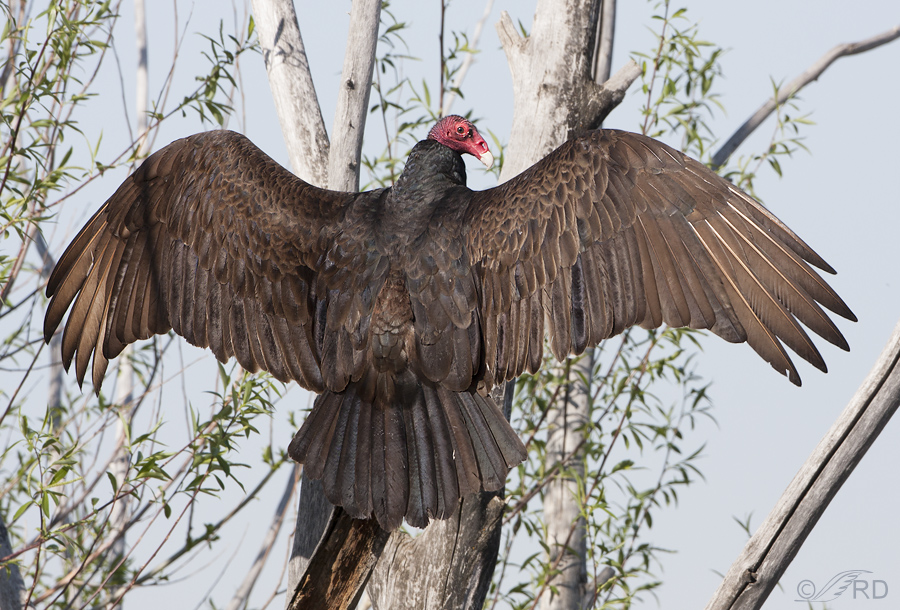Some folks think of Turkey Vultures as pretty revolting birds. Personally, I find that to be an unfair characterization but perhaps some of the following facts will explain the reaction some have toward these vultures. (warning – I suggest that you not be eating as you read this…)
Turkey Vultures:
- are carrion eaters
- prefer fresh carrion but they can’t open the carcass of thick-skinned animals so they often wait until it is putrid and soft before they dine.
- typically enter the carcass through the genitals, anus, nostrils or mouth and consume the tongue and eyes first
- will eat almost anything that is dead, including skunks. But even Turkey Vultures have limits and they will often eat around skunk scent glands and leave them behind.
- deliberately defecate on their own legs and feet, possibly as a cooling mechanism.

1/1000, f/8, ISO 500, 500 f/4, natural light
They also often assume poses similar to this one when in direct sunlight. This behavior is thought to be a form of thermoregulation or a way of utilizing the sterilizing effect of ultraviolet on their plumage. Or both.
Yes, some of the behaviors of this species tend to put some of us off a bit but it’s nice that there’s someone “out there” to clean up all of those nasty carcasses. In fact, the genus name for this bird, Cathartes, means “purifier”. Quite appropriate, I think.
Ron
Note: I’m on a camping/photo trip for a few days and will be largely out of touch until my return. I’ll catch up on answering comments and any questions when I return.


Serendipity. I have just come away from someone else’s blog. She went to an Autumn festival. Among the other delights was a board about the Turkey Vultures awesomeness. She can be found at http://carolabartz.blogspot.com.au/2012/10/fall-festival.html
That’s a fun post Elephants Child. And they didn’t forget the part about “projectile vomiting”, like I did. I left a comment…
You are just in time for Halloween with your description of the Turkey Vulture’s eating habits. So I will just respond with a junior high expression: “Awesome!”
“Awesome” works just fine for me Tana. Thanks!
Oh, they are so CUTE!
There is one more disgusting habit that should be on the list. When a Turkey Vulture feels threatened, it casually throws up. Consider the condition of the original food, and then imagine it warm and partially digested. The smell has no match. Would be predators quickly lose their appetites and retreat. It’s a very effective defense strategy.
Thanks for the reminder Mikal. I knew that little bit of interesting behavior (in fact I used to teach my zoology students about it) but I forgot to mention it in my post. Getting old, I guess…
As I have said before, that they call there food outlets, “Carrion Carryout” 🙂 Seriously, my relatives from Michigan visited a couple of years ago, and they were absolutely fascinated with the Turkey Vultures. Go figure.
We see them quite frequently, in the early mornings, several will be lined up on fences with their wings spread. We were told that they were were warming their wings in the rising sun, prior to rising to glide the thermals. Great photo, by the way.
Thanks Bob. We see them often too but they’re nearly always soaring high overhead. It’s rare for me to get close to a perched vulture.
Beautiful image… And as you say, SUCH an integral part of our ecosystems! Without them — as we’ve seen in some countries, where their populations have suffered (India comes to mind, when they suffered at what some believe to be pesticides) — humans wouldn’t be happy. I had no idea about the “purifier” naming; FASCINATING! Dead-on, no pun intended. 🙂
“Dead on” – pun appreciated, Christina.
Thank you. I knew most of these things but I don’t think I have ever appreciated just how unfortunate looking their heads are. The wing span looks impressive, but that head… Such a useful bird. Sadly unappreciated.
Elephant’s Child – yep, their heads are a little…. strange looking.
Ron, what disgustingly interesting facts! The only reason I already knew they defecated on their legs is because in my research on banding, I learned that Turkey Vultures can’t practically be banded on their legs, owing to this habit and its sanitation consequences. I so love these birds. They are ubiquitous in the Bay Area and I miss their constant presence.
Thanks Ingrid – I love knowing little “factoids” like the info you shared about them not being able to be banded because of the sanitation issues. That’s one I was unaware of.
Very nice, Ron, I also like the way you can see right through both nares. But you didn’t mention another of the Vulture’s charming habits. When threatened, they throw up on the attacker. Considering their favored foods, it’s a very effective defense. The smell is usually enough to destroy the appetite and the will of any predator.
Aren’t they the coolest!!! They fill an important niche… I like the previous Hideous pinheadious and also the Beauteous buteos… very smart. Buteos are beautiful!
Exactly Nicole, we’d be in a mess without them.
They are magnificent flyers, but are so unfortunate looking. I’ve heard they have no feathers on their heads as a mechanism to keep bacterial growth down. I think it rather makes them look like a featherless bird dressed up in a turkey costume. My sister and I laughingly refer to them as Hideous pinheadious. By contrast, we refer to Buteos as Beauteous buteos. Just a bit of silliness when we’re out birding. I hope you are having a wonderful time camping and can’t wait to see your images!
Sharon, I love “Hideous pinheadious”, especially. Had a wonderful time camping – didn’t get close to a lot of birds but the wild country we were in was spectacular and the weather was perfect.